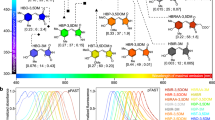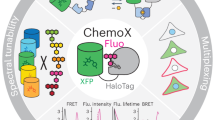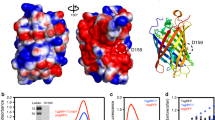Abstract
Spectrally separated fluorophores allow the observation of multiple targets simultaneously inside living cells, leading to a deeper understanding of the molecular interplay that regulates cell function and fate. Chemogenetic systems combining a tag and a synthetic fluorophore provide certain advantages over fluorescent proteins since there is no requirement for chromophore maturation. Here, we present the engineering of a set of spectrally orthogonal fluorogen-activating tags based on the fluorescence-activating and absorption shifting tag (FAST) that are compatible with two-color, live-cell imaging. The resulting tags, greenFAST and redFAST, demonstrate orthogonality not only in their fluorogen recognition capabilities, but also in their one- and two-photon absorption profiles. This pair of orthogonal tags allowed the creation of a two-color cell cycle sensor capable of detecting very short, early cell cycles in zebrafish development and the development of split complementation systems capable of detecting multiple protein–protein interactions by live-cell fluorescence microscopy.

This is a preview of subscription content, access via your institution
Access options
Access Nature and 54 other Nature Portfolio journals
Get Nature+, our best-value online-access subscription
$29.99 / 30 days
cancel any time
Subscribe to this journal
Receive 12 print issues and online access
$259.00 per year
only $21.58 per issue
Buy this article
- Purchase on Springer Link
- Instant access to full article PDF
Prices may be subject to local taxes which are calculated during checkout




Similar content being viewed by others
Data availability
All data generated during this study are included in this published article (and its Supplementary Information files) or are available from the corresponding author on reasonable request.
Code availability
Script for plotting the flow cytometry analysis are available at https://github.com/agtebo/NCB-orthogonal. The Localizer scripts for Igor Pro 8 (SOFI acquisition and treatment) are available on the repository: https://bitbucket.org/pdedecker/localizer/.
References
Tsien, R. Y. Constructing and exploiting the fluorescent protein paintbox (Nobel Lecture). Angew. Chem. Int. Ed. Engl. 48, 5612–5626 (2009).
Grimm, J. B. et al. A general method to improve fluorophores for live-cell and single-molecule microscopy. Nat. Methods 12, 244–250 (2015).
Los, G. V. et al. HaloTag: a novel protein labeling technology for cell imaging and protein analysis. ACS Chem. Biol. 3, 373–382 (2008).
Keppler, A. et al. A general method for the covalent labeling of fusion proteins with small molecules in vivo. Nat. Biotechnol. 21, 86–89 (2002).
Gautier, A. et al. An engineered protein tag for multiprotein labeling in living cells. Chem. Biol. 15, 128–136 (2008).
Gautier, A. & Tebo, A. G. Fluorogenic protein-based strategies for detection, actuation, and sensing. Bio. Essays 67, 509–510 (2018).
Li, C. et al. Dynamic multicolor protein labeling in living cells. Chem. Sci. 8, 5598–5605 (2017).
Plamont, M.-A. et al. Small fluorescence-activating and absorption-shifting tag for tunable protein imaging in vivo. Proc. Natl Acad. Sci. USA 113, 497–502 (2016).
Tebo, A. G., Pimenta, F. M., Zhang, Y. & Gautier, A. Improved chemical-genetic fluorescent markers for live cell microscopy. Biochemistry 57, 5648–5653 (2018).
Tebo, A. G. & Gautier, A. A split fluorescent reporter with rapid and reversible complementation. Nat. Commun. 10, 2822 (2019).
Glasgow, J. E., Salit, M. L. & Cochran, J. R. In vivo site-specific protein tagging with diverse amines using an engineered sortase variant. J. Am. Chem. Soc. 138, 7496–7499 (2016).
Thomas, F. et al. De novo-designed α-helical barrels as receptors for small molecules. ACS Synth. Biol. 7, 1808–1816 (2018).
Obexer, R. et al. Emergence of a catalytic tetrad during evolution of a highly active artificial aldolase. Nat. Chem. 9, 50–56 (2017).
Martínez, L. et al. Gaining ligand selectivity in thyroid hormone receptors via entropy. Proc. Natl Acad. Sci. USA 106, 20717–20722 (2009).
Das, R. et al. Dynamically driven ligand selectivity in cyclic nucleotide binding domains. J. Biol. Chem. 284, 23682–23696 (2009).
Pessoa, J., Fonseca, F., Furini, S. & Morais-Cabral, J. H. Determinants of ligand selectivity in a cyclic nucleotide-regulated potassium channel. J. Gen. Physiol. 144, 41–54 (2014).
Brogi, S., Tafi, A., Désaubry, L. & Nebigil, C. G. Discovery of GPCR ligands for probing signal transduction pathways. Front. Pharmacol. 5, 255 (2014).
Engelowski, E. et al. Synthetic cytokine receptors transmit biological signals using artificial ligands. Nat. Commun. 9, 2034 (2018).
Grimm, J. B. et al. A general method to fine-tune fluorophores for live-cell and in vivo imaging. Nat. Methods 14, 987–994 (2017).
Chen, X. et al. Visualizing RNA dynamics in live cells with bright and stable fluorescent RNAs. Nat. Biotechnol. 37, 1287–1293 (2019).
Philip, A. F., Nome, R. A., Papadantonakis, G. A., Scherer, N. F. & Hoff, W. D. Spectral tuning in photoactive yellow protein by modulation of the shape of the excited state energy surface. Proc. Natl Acad. Sci. USA 107, 5821–5826 (2010).
Shaner, N. C. et al. Improved monomeric red, orange and yellow fluorescent proteins derived from Discosoma sp. red fluorescent protein. Nat. Biotechnol. 22, 1567–1572 (2004).
Pimenta, F. M. et al. Chromophore renewal and fluorogen-binding tags: a match made to last. Sci. Rep. 7, 12316 (2017).
Padilla-Parra, S., Audugé, N., Tramier, M. & Coppey-Moisan, M. Time-domain fluorescence lifetime imaging microscopy: a quantitative method to follow transient protein–protein interactions in living cells. Cold Spring Harb. Protoc. 2015, 508–521 (2015).
Dertinger, T., Colyer, R., Iyer, G., Weiss, S. & Enderlein, J. Fast, background-free, 3D super-resolution optical fluctuation imaging (SOFI). Proc. Natl Acad. Sci. USA 106, 22287–22292 (2009).
Dedecker, P., Mo, G. C. H., Dertinger, T. & Zhang, J. Widely accessible method for superresolution fluorescence imaging of living systems. Proc. Natl Acad. Sci. USA 109, 10909–10914 (2012).
Moeyaert, B. & Dedecker, P. PcSOFI as a smart label-based superresolution microscopy technique. Methods Mol. Biol. 1148, 261–276 (2014).
Zhang, X. et al. Development of a reversibly switchable fluorescent protein for super-resolution optical fluctuation imaging (SOFI). ACS Nano 9, 2659–2667 (2015).
Moeyaert, B., Vandenberg, W. & Dedecker, P. SOFIevaluator: a strategy for the quantitative quality assessment of SOFI data. Biomed. Opt. Express 11, 636 (2020).
Vandenberg, W., Leutenegger, M., Duwé, S. & Dedecker, P. An extended quantitative model for super-resolution optical fluctuation imaging (SOFI). Opt. Express 27, 25749–25766 (2019).
Sakaue-Sawano, A. et al. Visualizing spatiotemporal dynamics of multicellular cell-cycle progression. Cell 132, 487–498 (2008).
Sugiyama, M. et al. Illuminating cell-cycle progression in the developing zebrafish embryo. Proc. Natl Acad. Sci. USA 106, 20812–20817 (2009).
Sakaue-Sawano, A. et al. Genetically encoded tools for optical dissection of the mammalian cell cycle. Mol. Cell 68, 626–640.e5 (2017).
Kimmel, C. B. & Law, R. D. Cell lineage of zebrafish blastomeres. I. Cleavage pattern and cytoplasmic bridges between cells. Developmental Biol. 108, 78–85 (1985).
Keller, P. J., Schmidt, A. D., Wittbrodt, J. & Stelzer, E. H. K. Reconstruction of zebrafish early embryonic development by scanned light sheet microscopy. Science 322, 1065–1069 (2008).
Olivier, N. et al. Cell lineage reconstruction of early zebrafish embryos using label-free nonlinear microscopy. Science 329, 967–971 (2010).
Mendieta-Serrano, M. A., Schnabel, D., Lomelí, H. & Salas-Vidal, E. Cell proliferation patterns in early zebrafish development. Anat. Rec. 296, 759–773 (2013).
Langley, A. R., Smith, J. C., Stemple, D. L. & Harvey, S. A. New insights into the maternal to zygotic transition. Development 141, 3834–3841 (2014).
Erdmann, R. S. et al. Labeling strategies matter for super-resolution microscopy: a comparison between HaloTags and SNAP-tags. Cell Chem. Biol. 26, 584–592.e6 (2019).
Gibson, D. G. et al. Enzymatic assembly of DNA molecules up to several hundred kilobases. Nat. Methods 6, 343–345 (2009).
Gietz, R. D. & Schiestl, R. H. High-efficiency yeast transformation using the LiAc/SS carrier DNA/PEG method. Nat. Protoc. 2, 31–34 (2007).
Duwé, S., Vandenberg, W. & Dedecker, P. Live-cell monochromatic dual-label sub-diffraction microscopy by mt-pcSOFI. Chem. Commun. 53, 7242–7245 (2017).
Pardon, E. et al. A general protocol for the generation of Nanobodies for structural biology. Nat. Protoc. 9, 674–693 (2014).
Dedecker, P., Duwé, S., Neely, R. K. & Zhang, J. Localizer: fast, accurate, open-source, and modular software package for superresolution microscopy. J. Biomed. Opt. 17, 126008 (2012).
Acknowledgements
We thank K.D. Wittrup, for providing us with the pCTCON2 vector and the EBY100 yeast strain for the yeast display selection. We also thank the flow cytometry facility Cytométrie Imagerie Saint-Antoine of UMS LUMIC at the Faculty of Medicine of Sorbonne University and, particularly, A. Munier for her assistance. This work has been supported by the European Research Council (ERC-2016-CoG-724705 FLUOSWITCH to A.G., ERC StG 714688 NanoCellActivity to P.D. and ERC-2019-CoG-863869 FUSION to S.P.-P.), the Wellcome Trust Core Award (203141 to S.P.-P.), and the Research Foundation-Flanders (G0B8817N to P.D. and 1514319N to B.M.).
Author information
Authors and Affiliations
Contributions
A.G.T. and A.G. conceived the project. A.G.T., B.M., M.T., M.V., S.P.-P., P.D., S.V. and A.G. designed the experiments. A.G.T., B.M., M.T., I.C.-A., D.B., M.V. and S.V. performed the experiments. A.G.T., B.M., M.T., I.C.A., M.V., S.P.-P., P.D., S.V. and A.G. analyzed the experiments. A.G.T. and A.G. wrote the paper with the help of all the authors.
Corresponding author
Ethics declarations
Competing interests
The authors declare the following competing financial interest: A.G. is cofounder and hold equity in Twinkle Bioscience/The Twinkle Factory, a company commercializing the FAST technology.
Additional information
Publisher’s note Springer Nature remains neutral with regard to jurisdictional claims in published maps and institutional affiliations.
Extended data
Extended Data Fig. 1 Selection and design strategy for spectrally orthogonal FAST systems.
A yeast displayed library of FAST variants was screened in presence of both HMBR and HBR-3,5DOM in order to identify redFAST and greenFAST.
Extended Data Fig. 2 Engineering of greenFAST and redFAST.
Comparison of the KDs (in μM) for HMBR and HBR-3,5DOM of FAST (blue star) and clones selected from FACS (a) and variants constructed through rational design (b, filled markers). Green dots: greenFAST selection, magenta dots: redFAST selection.
Extended Data Fig. 3 Characterization of greenFAST and redFAST.
a, b, Affinities of greenFAST and redFAST for a) HMBR and b) HBR-3,5DOM. Mean of n = 3, represented as mean ± sem, protein concentration 100 nM. (c, d) Determination of molar absorptivity for c) greenFAST and d) redFAST with their cognate fluorogen by forward titration and standardization with FAST (protein concentration, 40 µM). e, f, Determination of quantum yield for e) greenFAST and d) redFAST with their cognate fluorogen by reciprocal dilution using FAST:fluorogen as a standard (protein concentration, 40 µM).
Extended Data Fig. 4 Flow cytometry analysis.
Yeast cells expressing FAST (a), greenFAST (b) and greenFAST (c) were analyzed by flow cytometry in the presence of either only HMBR (5 μM) or HBR-3,5DOM (10 μM) or in the presence of both (5 μM HMBR and 10 μM HBR-3,5DOM). Efficient induction of protein expression was verified through independent labeling with an Alexa488-conjugated antibody. The analysis was done typically on about 110,000 cells. Supplementary Figure 1 exemplifies the gating strategy used. d, Representative confocal micrograph (n = 5 from 1 experiment) of a mixture of yeast cells expressing greenFAST (green) and redFAST (magenta) in the presence of 5 μM HMBR and 10 μM HBR-3,5DOM. Scale bar 10 μm.
Extended Data Fig. 5 Photostability measurements for greenFAST and redFAST.
a, b, comparison of greenFAST and FAST photostability in different illumination conditions. Both were expressed as H2B fusions in HEK293T and imaged with 10 μM HMBR. Images taken every a) 1 s and b) 10 s with 1.27 μs pixel dwell, excitation with 488 nm laser. c, d, Comparison of c) FAST and d) greenFAST photostability as a function of fluorogen concentration at 13 kW/cm2 for 488 nm laser, 1.27 μs pixel dwell, images taken every 1 s. 100 images were acquired followed by 60 s in the dark before acquisition was restarted. e, redFAST and FAST expressed in the cytosol in HEK293T cells labeled with 10 μM HBR-3,5DOM were illuminated with 4.9 kW/cm2 for 541 nm laser, 1.27 μs pixel dwell, images taken every 1 s.
Extended Data Fig. 6 Cell cycle sensors based on orthogonal FASTs.
a–d, Representative micrograph (n = 8 from 3 experiments) of U2OS cells stably expressing a FUCCI cell cycle sensor. a, Design of a mammalian cell cycle sensor. Tracking of individual cell cycles is possible through stable expression of redFAST-hCdt(30–120) and greenFAST-hGem(1–120). b–d, Cell A can be tracked S/G2 (b, 40 mins) through division (c, 6 hrs 10 mins) while Cell B (c, top arrow) can be tracked through the G1-S transition (d, 19 hrs 50 mins). Images were taken every 5 mins. 5 μM HMBR and 10 μM HBR-3,5DOM. Scale bars 10 μm.
Extended Data Fig. 7 Effects of the fluorogens on zebrafish embryogenesis.
Zebrafish embryos were incubated with 5 μM fluorogen during 1 h at 50% epiboly or overnight (ON) from 50% epiboly to 24 hpf. The graph shows the percentage of embryos with no defect (white), axis defects (grey), or dead (black) at 48 hpf. Controls untreated and treated with DMSO only were performed. The number (n) of embryos used for each condition is indicated.
Extended Data Fig. 8 Kinetics of association and dissociation of split-greenFAST and split-redFAST.
a, b, Representative micrographs (n = 3 from 3 experiments) of HEK293T cells co-expressing FK506-binding protein (FKBP) fused to CFAST11 and FKBP-rapamycin-binding domain of mammalian target of rapamycin (FRB) fused to either greenNFAST (a) or redNFAST (b) were labeled with both 5 μM HMBR and 10 μM HBR-3,5DOM, and imaged before and after addition of 500 nM rapamycin. The green channel shows HMBR fluorescence, while the magenta channel shows HBR-3,5DOM fluorescence. Graphs show the temporal evolution of the fluorescence intensity of individual cells (n = 7 and 8) after rapamycin addition. c, d, Representative micrographs (n = 3 from 3 experiments) of HEK293T cells co-expressing FKBP fused to CFAST11 and FBBP fused to either greenNFAST (c) or redNFAST (d) treated with 100 nM AP1510 and labeled with both 5 μM HMBR and 10 μM HBR-3,5DOM. Cells were then imaged before and after the addition of 1.1 μM rapamycin. The green channel shows HMBR fluorescence, while the magenta channel shows HBR-3,5DOM fluorescence. Graphs show the temporal evolution of the fluorescence intensity of individual cells (n = 8 and 11) after rapamycin addition.
Supplementary information
Supplementary Information
DNA and protein sequences of greenFAST, redFAST; Supplementary Fig. 1 and Tables 1–12.
Supplementary Video 1
Zebrafish embryos were injected with redFAST-zGem(1–100)-P2A-greenFAST-zCdt1(1–190) mRNA at the one-cell stage, and timelapse imaging was performed starting from the 256-cell stage on embryos incubated with 5 μM of HMBR and 5 μM of HBR-3,5DOM. Scale bar is 20 μm. Images every 5 min.
Supplementary Video 2
Whole-zebrafish embryo imaging. Zebrafish embryos were injected with redFAST-zGem(1–100)-P2A-greenFAST-zCdt1(1–190) mRNA at the one-cell stage, and timelapse imaging was performed starting from the 256-cell stage on embryos incubated with 5 μM of HMBR and 5 μM of HBR-3,5DOM. Scale bar is 100 μm.
Supplementary Video 3
Detection of FKBP–FKBP homodimer encoded by split-redFAST followed by detection of FRB–FKBP detected by split-greenFAST using timelapse imaging in HEK293T cells labeled with 5 μM of HMBR and 10 μM of HBR-3,5DOM. First, the cells were treated with 100 nM of AP1510 (imaged every 5 min), and then at t = 140 min AP1510 was removed and 1 µM of rapamycin was added (imaged every 30 s). Scale bar, 20 μm.
Rights and permissions
About this article
Cite this article
Tebo, A.G., Moeyaert, B., Thauvin, M. et al. Orthogonal fluorescent chemogenetic reporters for multicolor imaging. Nat Chem Biol 17, 30–38 (2021). https://doi.org/10.1038/s41589-020-0611-0
Received:
Accepted:
Published:
Issue Date:
DOI: https://doi.org/10.1038/s41589-020-0611-0
This article is cited by
-
Biomimetic NIR-II fluorescent proteins created from chemogenic protein-seeking dyes for multicolor deep-tissue bioimaging
Nature Communications (2024)
-
A fluorogenic chemically induced dimerization technology for controlling, imaging and sensing protein proximity
Nature Methods (2023)
-
Caveat fluorophore: an insiders’ guide to small-molecule fluorescent labels
Nature Methods (2022)
-
Structure-based rational design of an enhanced fluorogen-activating protein for fluorogens based on GFP chromophore
Communications Biology (2022)
-
Autotrophic lactate production from H2 + CO2 using recombinant and fluorescent FAST-tagged Acetobacterium woodii strains
Applied Microbiology and Biotechnology (2022)



